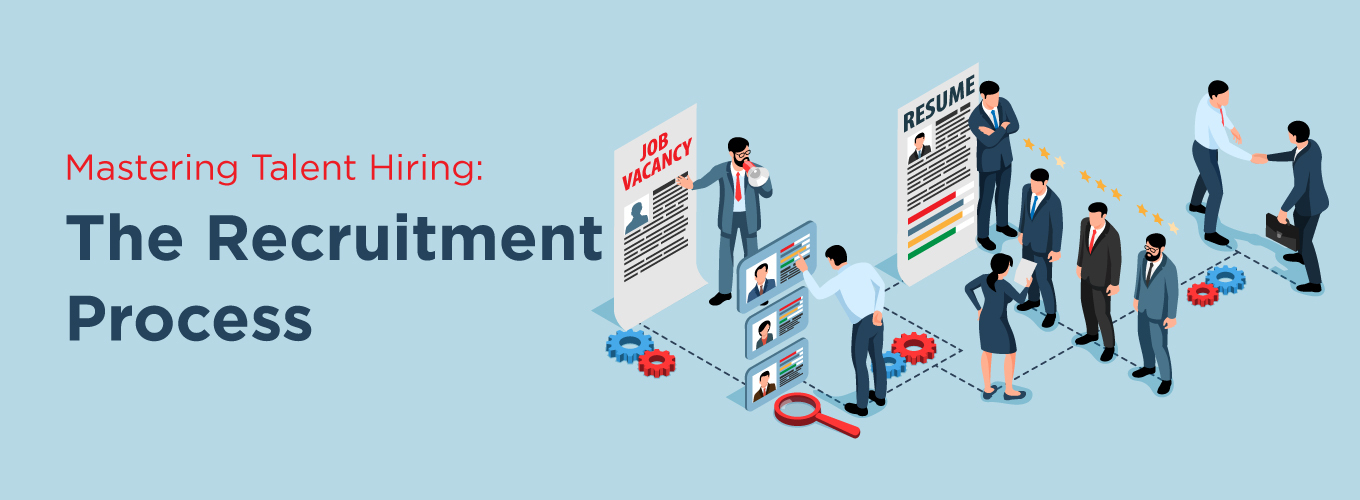What is the recruitment process?
Identifying Needs: Identify the need for the recruitment process and the job purpose statement with outlined roles, responsibilities and required qualifications.
Job Posting: Use job boards, social networking sites, company websites, and recruiting agencies to advertise the vacancies.
Application Screening: Screen submitted applications and CV of prospective candidates who meet the conditions for the particular job description.
Initial Contact: Communicate with preselected candidates for an an interview or an initial screening.
Interviews: Interviews can range from a first screening to multiple interviews involving panels or different stakeholders. Measures can include formative assessments, which are skill-based and summative psychometric tests.
Decision Making: Assessing the best candidate through an interview, evaluation of assessments and qualifications.
Job Offer: Make a job offer to the chosen person while covering matters such as compensation, pay-offs and the commencement date.
Onboarding: Train the new hire to acquaint him or her with the environment, introduce him or her to other employees, and introduce them to policy and organisational culture.
Communication: Keep on informing both successful and unqualified candidates to offer them an experience that will be satisfactory to each one of them.
Table of Contents
What is a candidate’s experience in recruitment?
In a recruitment process, the candidate’s experience simply means the cumulative opinions and feelings evoked when interacting with a recruiter. It is a holistic view of all interactions ranging from the first conversation to post-process feedback about an interview, including communication, user experience in filling out the application form, interview arrangement, as well as its final feeling. A good candidate experience is essential for attracting high-quality job seekers and building a favourable image about an organisation.
It begins with the job listing: clear, informative, and enticing. In addition, the recruitment process should be straightforward, unencumbered, and real-time, making potential applicants believe they are valued and esteemed individuals. Communication in time, issuing information on the status of an application demonstrates openness and respect. An organized and respectful process during interviews strengthens perceptions that the prospective employee has of the corporate culture and professionalism.
Giving candid and prompt post-interview feedback, whether positive or negative, increases a candidate’s perception of organisational professionalism and openness.
In addition, a favourable candidate’s experience affects an individual’s decision of whether or not to take up the offer and how they see the organisation as well. Those who are not fortunate enough to get the position can, in turn, serve as brand advocates if they had a positive experience during the interview session. The end outcome is that an employer is given a chance to develop a competitive advantage as far as recruitment and staff retention are concerned when it comes to promoting their employer brand.
Why do you need a strong recruitment process and strategy?
There are many reasons why a strong recruitment process procedure together with an appropriate method is necessary in an organisation. First of all, it is an important aspect in attracting the best available workforce. Well-defined processes help attract people with relevant expertise, experience, and culture that complement the company’s goals and vision. This makes sure that workers have something meaningful that relates to the success of the organisation and its philosophy.
Additionally, a well-thought-out recruitment process diminishes the likelihood of bad hires. The hiring process is rigorous in the way that it includes strict screening interviews and assessments that minimise the chance of getting the wrong employee. Consequently, this leads to lower employee turnover and a reduced cost of continuous recycling.
Also, a systematic recruitment process is instrumental in promoting a good employer brand. A smooth and honourable recruitment process leaves pleasant memories even among unsuccessful people. This good impression may convert rejected applicants into advocates who positively affect the employer’s image in the job market.
Also, it is essential for recruitment to be organised in such a way that hiring will follow the corporate vision and plans of development. That talent acquired should not just be needed for current positions but could develop it for higher positions in an organisation. This strategic perspective supports succession planning which enables internal development with an avoidance of hiring from outside for these high-profile positions.
However, in general, a robust recruitment plan and procedure will play an essential part in recruiting competent personnel, minimising staff churn rate, building superior employer image and connecting recruiting with long-term organisational purposes. The foundation for creating an experienced, engaged, and united workforce that is needed for steady improvements is this.
Conclusion
However, in the area of talent acquisition, being able to perfect the recruitment process is a crucial post in the edifice of organisational success. The best-suited candidates are those that do fit in relation to the requisite of a particular job and the nature of an organisation.
The recruitment procedure involves keenly examining applications, carrying out extensive interviews, and incorporating in-depth evaluations to ensure that mismatch-related risks are reduced, thereby contributing to minimising turnovers and savings on resource allocations.
The process in question also goes beyond the mere filling of immediate vacancies in cities, as it involves long-term goals and strategic planning for talent acquisition that conforms to the corporate agenda. That’s where it breeds people with capabilities that go beyond their jobs, leading to both the development of homegrown talent and succession planning.
It is not only about the recruitment concluded in hiring but also enhances the positive employer brand. However, it creates an impression on every person, whether hired or rejected, and this may turn some of these rejected candidates into brand ambassadors.
Once the recruitment process is refined it becomes fundamental because only through having a trained group of qualified individuals who are willing to work will it be possible to build a solid base upon which the company could thrive and achieve success in today’s competitive world, characterised by unforgiving pressures
Frequently asked questions
1. What are the seven steps of the recruitment process?
Planning: Assess future needs and predict based on emerging vacancies and long-term staffing requirements. Make a strategic plan that defines hiring objectives, time frames, and essential resources.
Sourcing: Post ads in the local newspaper, on social media pages, and on job boards; ask for recommendations from current employees; attend networking events; or even personally search (headhunt) for those you want to hire. Use multiple channels to enlarge the candidate’s pool base.
Screening and shortlisting: Scan resumes or review applications, carry out the initial screening or assessment, and pre-screen applicants who closely meet the job criteria for detailed consideration.
Interviews and Assessments: Engage in deep interviewing using behavioural or competency-based questions. Carry out interviews, competency tests, or culture compatibility surveys for a proper candidate evaluation.
Selection Decision: Make an objective evaluation of how well a person performed during the interview, his assessment results, and other criteria that helped pick the best candidate for that particular position.
Offer and Negotiation: Issue an official job offer indicating terms like salary, benefits, commencement date, etc.; if necessary, negotiate terms for mutual understanding.
Closing and Onboarding: A hiring manager should confirm the candidate’s acceptance, conclude the recruitment process with other bidders, and start onboarding procedures. Ensure proper orientation, training, and provision of requisite material toward an easy fitment in an organisation.
2. What is the recruitment process in talent management?
The recruitment process of qualified people with appropriate skills, and competence and also those who can fit into the company’s culture is at the heart of talent management.
Recruitment process forms the broader context about various approaches for the identification of potential talents, their development, and retention. Thus, it encompasses a proactive strategy of anticipating and identifying appropriate human resources to meet present and future needs in terms of talent sourcing and screening.
3.What are the 4 pillars of the recruitment process?
Sourcing: This category focuses on the methods and means of drawing in possible job seekers. This comprises an array of methods, including job boards, social media, employee referral, networking, and education institutions/industry groups. Good sourcing increases the number of candidates, making it more diverse and inclusive.
Selection: This includes reviewing, testing, and weighing the merits of each potential candidate to fit into a particular position. Pillar one embodies a range of steps, including resume screening, interviews, tests, and reference scrutiny. The organisation applies rigorous selection of candidates for a position based on their skills, experience, cultural fit, and opportunities for development in the firm.
Engagement: Engagement is important once possible candidates have been found. The third pillar focuses on candidate relationship management during the hiring process. Engagement means that employers should communicate clearly and quickly in order to give a picture of their corporate culture; it also refers to offering a positive experience to candidates, even if they do not succeed.
Retention: Retention has usually been a facet of talent management after the recruitment process but has emerged as one of the supporting pillars of a recruitment strategy. This is the understanding of what makes employees satisfied and retain them as well as remaining motivated after joining an organisation. The proactive approach includes boarding, career development activities, and creating favourable working conditions for retaining the best talents.
4. What are the 8 principles of the recruitment process?
While the principles of the recruitment process may vary based on different perspectives, here are eight fundamental principles that often underpin effective recruitment strategies:
Alignment with Organizational Goals: Make sure that the recruitment process is consistent with the strategic aims of the organisation as well as its future vision. The goals for each hire should be aligned with these objectives.
Clear Job Descriptions: Draft specific and concise job descriptions specifying duties, qualifications, and needed competencies. Suitable candidates are attracted when there is clarity in the job description.
Effective Sourcing Strategies: Leverage various channels like job boards, social media sites, networks, etc. in order to tap into broader groups of prospective candidates.
Candidate-Centric Approach: Provide a positive candidate experience right from contact through onboarding, even when the hire may not eventually be made.
Structured Selection Process: Have a rigorous and consistent approach to selection with different evaluation techniques like interviews, assessments, and references for a proper consideration of the candidates’ profiles.
Transparency and Communication: Ensure constant, prompt and open communication with candidates, sharing recruitment progress reports, feedback and further plans.
Adherence to Diversity and Inclusion: Adopt a practice of recruiting staff from varied backgrounds based on diversity principles and have the necessary measures for all-inclusive employment.
Continuous Improvement: Keep on assessing and improving recruitment processes guided by performance indicators, feedback, and current practices in order to boost effectiveness and productivity.









